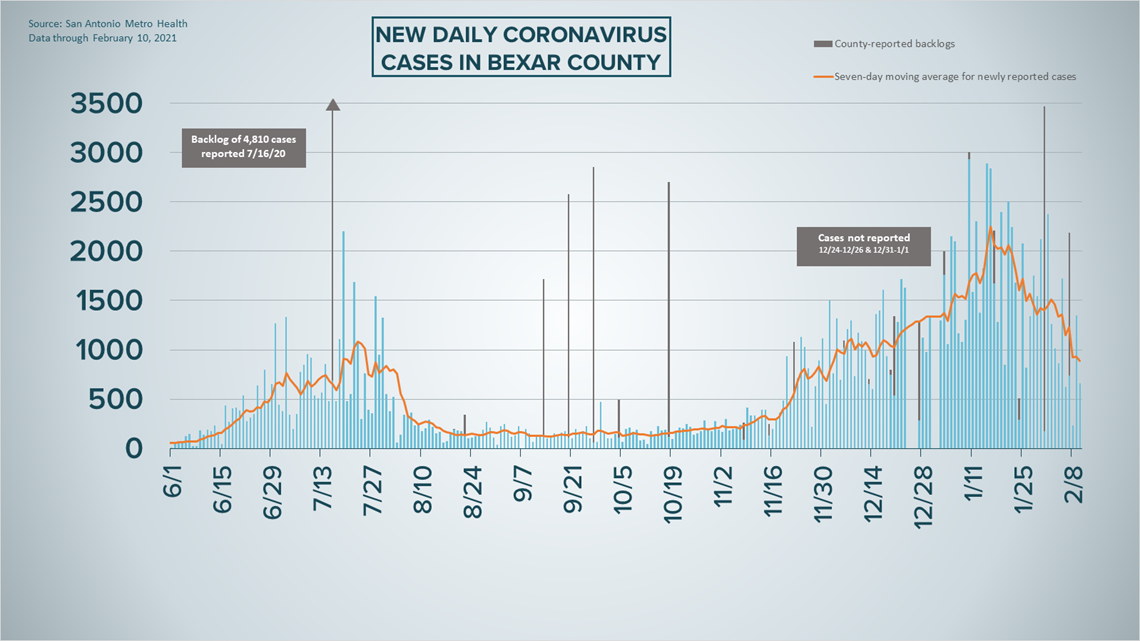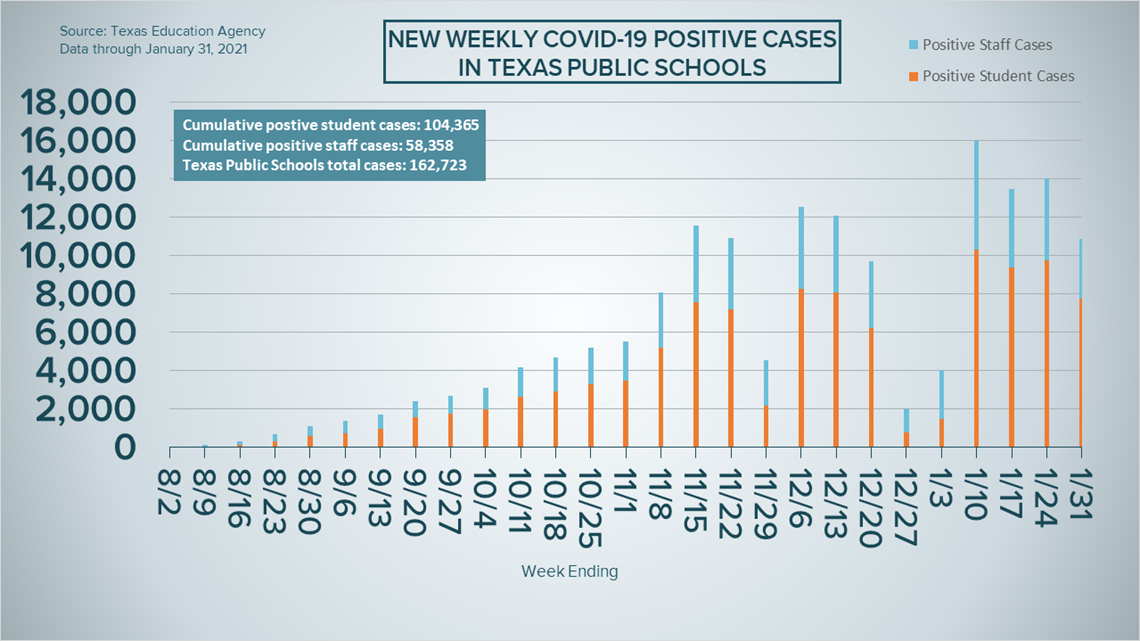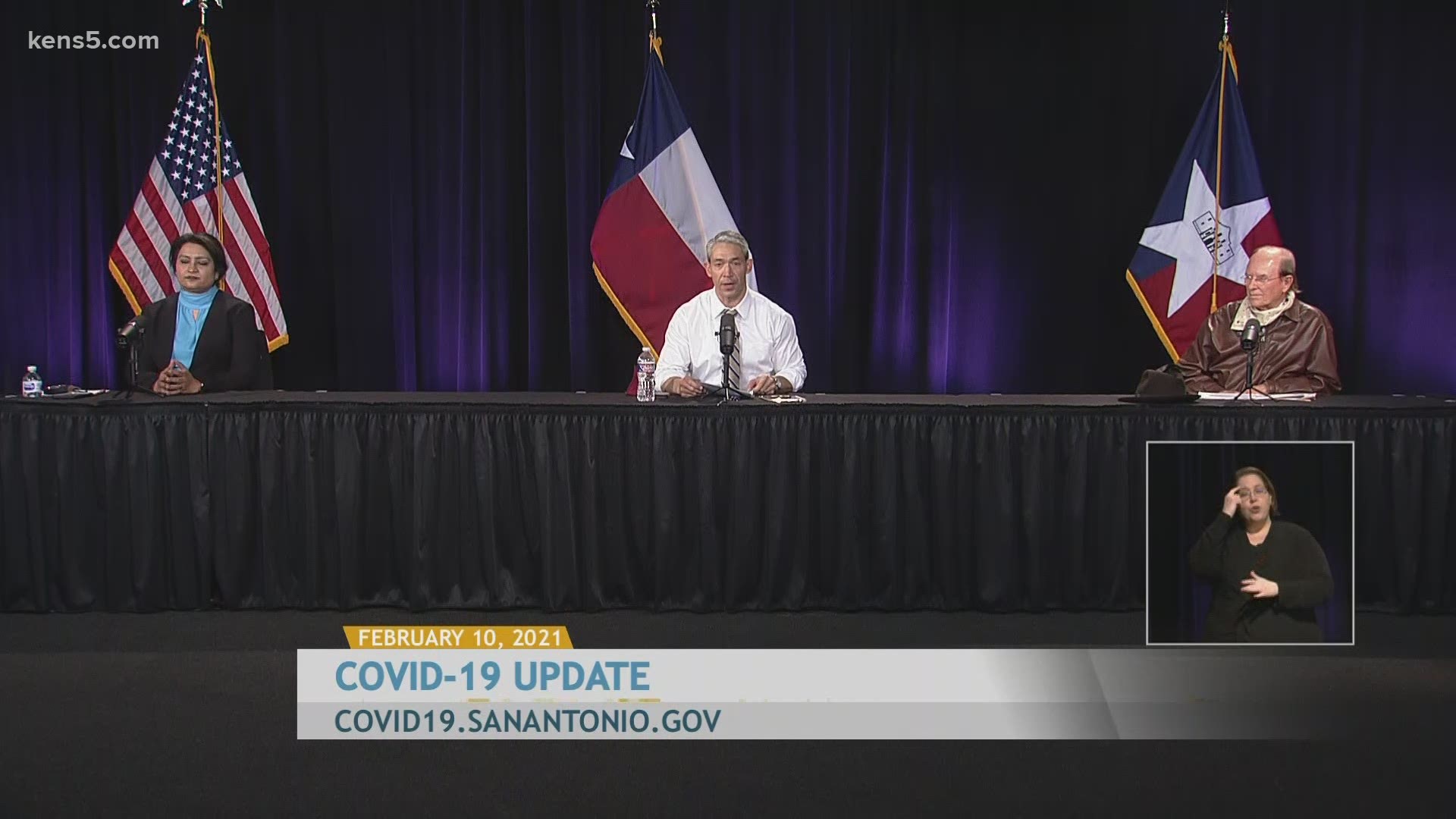SAN ANTONIO — We're tracking the latest numbers from the coronavirus pandemic in San Antonio and across Texas. Here are the latest numbers reported by Bexar and surrounding counties:
- Bexar County: On Wednesday, 660 new cases were reported, bringing the total number of cases to 185,444. Three new deaths were also reported, raising the local death toll to 2,365.
- Hays County: On Wednesday, officials reported 85 new cases in the county and one additional COVID-related fatality. As of Wednesday, there are a total of 15,794 lab-confirmed local cases, while the death toll increased to 201. Officials estimate 14,034 residents have recovered, while 1,559 are still ill with the virus.
- Comal County: On Wednesday, officials reported 114 new cases and no additional COVID-related fatalities. There are a total of 8,685 cases, including 4,554 confirmed and 4,112 probable cases, while 269 county residents have died due to COVID-19 complications. The county estimates 7,794 residents have recovered, while 622 are still ill with the virus.
More county case information is available through the Texas Department of Health Services COVID-19 dashboard.
How Bexar County is trending
We've tracked how many coronavirus cases have been confirmed in Bexar County from the time officials began reporting cases in March 2020. The graphic below shows the number of cases since June and charts those daily case numbers along a 7-day moving average to provide a more accurate picture of the overall coronavirus case curve in our area and the direction we're trending amid the pandemic.
On Wednesday, San Antonio Mayor Ron Nirenberg reported an additional 660 coronavirus cases in Bexar County, which raises the local diagnosis total to 185,444 since the pandemic began. This is the third case total in the last four days of fewer than 750 new cases, a trend that has brought the seven-day moving average for the county down to 884; on Sunday, it was 1,228.
Nirenberg also reported three new deaths from virus complications, however, after no fatalities were reported Tuesday. In all, 2,365 Bexar County residents have died from virus complications.


Hospitalizations continue to fall in the San Antonio community. On Wednesday, 855 patients were receiving treatment for their symptoms; that's 29 fewer overall patients than on Tuesday.
Of those 855, 198 are on ventilators (same figure as Tuesday) and 342 are in intensive care (one more than on Tuesday).


Coronavirus in Texas
The total number of novel coronavirus cases in the state since the pandemic began grew by 13,379 on Wednesday, according to the Texas Department of State Health Services. That total includes 9,936 new confirmed cases, 2,332 new probable cases, and a backlog of 773. More details can be found on this page.
Wednesday's figures bring the total number of Texans diagnosed with COVID-19 to more than 2.517 million.


Meanwhile, state health authorities reported another 385 deaths from coronavirus complications in Texas. In all, 39,386 Texans have died from COVID-19.
The number of COVID-19 patients receiving treatment for their symptoms throughout Texas decreased by 236, to a current count of 9,165. That continues the positive downward trend for Texas that began about two weeks ago, and brings statewide hospitalizations down to their lowest levels since Dec. 10.
The state, meanwhile, estimates that about 2.168 million Texans have recovered, while 291,240 Texans remain ill with COVID-19.
The latest update from the Texas Education Agency showed that there have been at least 162,723 cumulative cases among staff and students on Texas public school campuses through January 31. That number comprises 104,365 positive student cases and 58,358 staff cases. More information can be found here.


The TEA releases new data on school cases on Fridays.
Latest Coronavirus Headlines
- New COVID-19 variant detected in Comal County, one day after Bexar County also sees it
- CDC study finds two masks are better than one against COVID-19
- Texas pharmacies prepare for rollout of vaccines through federal program
- World's second-oldest person survives COVID-19 at age 116
- US COVID hospitalizations, new cases drop to lowest in months
- Your second COVID stimulus payment may differ from the first | Eyewitness Wants to Know
- VERIFY: It's not a good idea to travel yet, even if you've received the COVID vaccine, infectious disease expert says
Coronavirus symptoms
The symptoms of coronavirus can be similar to the flu or a bad cold. Symptoms include fever or chills, cough, shortness of breath or difficulty breathing, fatigue, muscle or body aches, headache, new loss of taste or smell sore throat, congestion or runny nose, nausea or vomiting, and diarrhea, according to the Centers for Disease Control.
Most healthy people will have mild symptoms. A study of more than 72,000 patients by the Centers for Disease Control in China showed 80 percent of the cases there were mild.
But infections can cause pneumonia, severe acute respiratory syndrome, kidney failure, and even death, according to the World Health Organization. Older people with underlying health conditions are most at risk.
Experts determined there was consistent evidence these conditions increase a person's risk, regardless of age:
- Chronic kidney disease
- COPD (chronic obstructive pulmonary disease)
- Obesity (BMI of 30 or higher)
- Immunocompromised state (weakened immune system) from solid organ transplant
- Serious heart conditions, such as heart failure, coronary artery disease, or cardiomyopathies
- Sickle cell disease
- Type 2 diabetes
The CDC believes symptoms may appear anywhere from two to 14 days after being exposed.
Human coronaviruses are usually spread...
- Between people who are in close contact with one another (within about 6 feet).
- Through respiratory droplets produced when an infected person coughs, sneezes or talks. These droplets can land in the mouths or noses of people who are nearby or possibly be inhaled into the lungs.
- Some recent studies have suggested that COVID-19 may be spread by people who are not showing symptoms.
Help stop the spread of coronavirus
- Stay home when you are sick.
- Eat and sleep separately from your family members
- Use different utensils and dishes
- Cover your cough or sneeze with your arm, not your hand.
- If you use a tissue, throw it in the trash.
Find a Testing Location
City officials recommend getting a COVID-19 test if you experience fever or chills, cough, shortness of breath or difficulty breathing, fatigue, muscle or body aches, headache, new loss of taste or smell, sore throat, congestion or runny nose, nausea or vomiting, or diarrhea.
San Antonio operates several no-cost testing locations, including two walk-up locations open Monday-Sunday from 10 a.m. until 2 p.m.:
Cuellar Community Center
5626 San Fernando St.
San Antonio, TX 78237
Ramirez Community Center
1011 Gillette Blvd.
San Antonio, TX 78224
Additionally, Freeman Coliseum offers drive-through no-cost testing from Monday through Sunday between 9 a.m. and 4 p.m. An appointment is required and can be made either online or by calling (833) 213-0643.
Here's a Testing Sites Locator to help you find the testing location closest to you in San Antonio.

